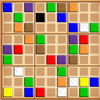
The first of the three puzzles (shown in Figure 1) is a simple 6 × 6 sudoku puzzle using symbols for the primary colors of light-red (R), green (G), and blue (B)-and the primary colors of pigments and dyes-cyan (C), magenta (M), and yellow (Y)-for the six unique symbols. The puzzles developed here use unique symbols taken from science and chemistry instead of the usual Arabic numerals. Each number in the solution therefore occurs only once in each of three directions, hence the “single symbols” implied by the puzzle’s name. The number of “clues” and their location in the puzzle determines the difficulty of the puzzle. However, each of the numbers 1–9 (or 1–6) can appear only once on each row, column, and box. Sudoku puzzle 2 using symbols of nine of the fourth period transition metal elements (Ti through Zn).įill in the remaining squares of each row, column, and box with the digits 1–9 (or 1–6) so that each row contains all the numbers from 1–9 (or 1–6), each column contains all the numbers from 1–9 (or 1–6), and each 3 × 3 box (or 2 × 3 box) contains all the numbers from 1–9 (or 1–6). Sudoku puzzle 1 using symbols for colors-the primaries of light: red (R), green (G), and blue (B) and pigment or dye primaries: cyan (C), magenta (M), and yellow (Y).įigure 2.

Some of the numbers are placed in the squares of the grid as “clues”. The classic sudoku puzzle is a number puzzle consisting of 9 × 9 grid (or a simpler 6 × 6 grid), divided into nine 3 × 3 boxes (or six 2 × 3 boxes). By replacing the Arabic numerals with symbols used in class, unique sudoku chemistry puzzles were created. The commonly used symbols are the Arabic numerals 1–6 or 1–9. Sudoku puzzles are based on six unique terms (for a 6 × 6 puzzle) or nine unique terms (for a 9 × 9 puzzle) used only once in a row, column, or box. Sudoku puzzles were created that use light science and chemistry terms taught in a nonmajor course, Chemistry of Art and Color. In order to capitalize on the craze, three The puzzles are popular with Columbia College Chicago students as well. In April 2005, The New York Post published sudoko puzzles as a regular feature and by July 2005, the puzzle surged in popularity all over the country (1, 2). Later the name was abbreviated to sudoku (pronounced SUE-dough-coo “su” means number, “doku” means single). “Suuji wa dokushin ni kagiru” may be translated as “the numbers must be single” or “the numbers must occur only once”. In April 1984, the puzzle was introduced in Japan and the name “sudoku” was assigned to the puzzle. The precursor of the sudoku puzzle was first published in the United States in 1979 by Howard Garns, a retired architect and freelance puzzle constructor. Welsh Science and Mathematics Department, Columbia College, Chicago, IL 60605-1996
#Online color sudoku download
If you'd like to download directions and the game boards for this preschool and kindergarten math game, click on the image below.Chemistry of Art and Color Sudoku Puzzles

Note: If you don't have paint chips, you could use colored cardstock, wrapping paper, construction paper–whatever you have! If you need me to make an easier version, please let me know. Now you're all set to play Color Sudoku! If the boards are too challenging for your kiddo, figure out the right places to add some squares and start with easier boards. Print one of the game boards (found at the bottom of this post) and choose one color for each number. You only need FOUR chips for each game board.Ĭut each paint chip into FOUR equal (or somewhat equal) pieces. So, the idea for Paint Chip Sudoku was born!įirst, you need to get some of the larger paint chips. I found some printable things online, but I didn't want to use a bucket of colored ink. Elijah has Colorku, and I was thinking it would be fun to have something similar (but simpler) for Simon.

Here is a fun logic-mathy activity for your preschool or kindergarten student.


 0 kommentar(er)
0 kommentar(er)
